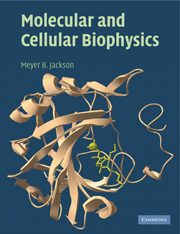Book contents
- Frontmatter
- Contents
- Preface
- Acknowledgements
- Chapter 1 Global transitions in proteins
- Chapter 2 Molecular forces in biological structures
- Chapter 3 Conformations of macromolecules
- Chapter 4 Molecular associations
- Chapter 5 Allosteric interactions
- Chapter 6 Diffusion and Brownian motion
- Chapter 7 Fundamental rate processes
- Chapter 8 Association kinetics
- Chapter 9 Multi-state kinetics
- Chapter 10 Enzyme catalysis
- Chapter 11 Ions and counterions
- Chapter 12 Fluctuations
- Chapter 13 Ion permeation and membrane potential
- Chapter 14 Ion permeation and channel structure
- Chapter 15 Cable theory
- Chapter 16 Action potentials
- Appendix 1 Expansions and series
- Appendix 2 Matrix algebra
- Appendix 3 Fourier analysis
- Appendix 4 Gaussian integrals
- Appendix 5 Hyperbolic functions
- Appendix 6 Polar and spherical coordinates
- References
- Index
Chapter 9 - Multi-state kinetics
Published online by Cambridge University Press: 24 May 2010
- Frontmatter
- Contents
- Preface
- Acknowledgements
- Chapter 1 Global transitions in proteins
- Chapter 2 Molecular forces in biological structures
- Chapter 3 Conformations of macromolecules
- Chapter 4 Molecular associations
- Chapter 5 Allosteric interactions
- Chapter 6 Diffusion and Brownian motion
- Chapter 7 Fundamental rate processes
- Chapter 8 Association kinetics
- Chapter 9 Multi-state kinetics
- Chapter 10 Enzyme catalysis
- Chapter 11 Ions and counterions
- Chapter 12 Fluctuations
- Chapter 13 Ion permeation and membrane potential
- Chapter 14 Ion permeation and channel structure
- Chapter 15 Cable theory
- Chapter 16 Action potentials
- Appendix 1 Expansions and series
- Appendix 2 Matrix algebra
- Appendix 3 Fourier analysis
- Appendix 4 Gaussian integrals
- Appendix 5 Hyperbolic functions
- Appendix 6 Polar and spherical coordinates
- References
- Index
Summary
The two-state model of Chapter 7 can be used as a basic building block for more complicated processes. When a system has more than two states, conversions between different pairs can occur, and then the kinetics reflects the aggregate behavior of those various transitions. The time course is no longer a simple exponential function, and in this chapter we will see how multi-state models lead to multi-exponential kinetics.
Much of Chapter 7 probed the fundamental physical processes that govern the speed of a transition. Now we will accept the basic phenomenon of a transition with a given rate, put some of these transitions together, and work out the dynamic behavior of these more complicated systems. The mathematical method for handling multi-state kinetics is very robust and powerful. With them one can develop quantitative descriptions for a general class of models. Aside from kinetic problems in biophysics, the mathematics introduced in this chapter has been applied to an extraordinarily wide range of fields from stochastic processes in physics to population dynamics in ecology.
Multi-state kinetics has considerable practical value, because most models for molecular mechanisms involve interconversions between a few distinct states. Kinetic behavior often provides the most direct experimental tool for testing the predictions of such a model.
The three-state model
Many important features of multi-state kinetics can be illustrated with this example.
- Type
- Chapter
- Information
- Molecular and Cellular Biophysics , pp. 216 - 247Publisher: Cambridge University PressPrint publication year: 2006



